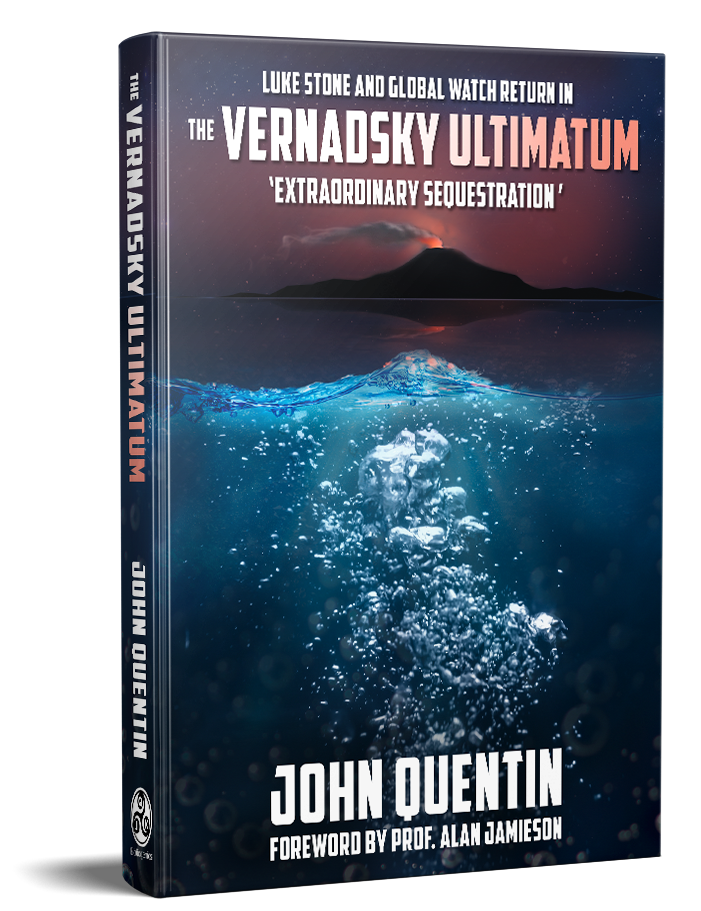John Quentin’s prescient, prognostic novel The Vernadsky Ultimatum takes up where its profound, prophetic predecessor, The Galathea Legacy, left off. It broadcasts the venerable, vivid vision of Academician Vladimir Vernadsky and considers the vulnerability of two vast volumes of greenhouse gas trapped deep under water on opposite sides of the world. One of these is a consequence of the Earth’s natural activity; the other a consequence of unnatural human interference with the Earth. One poses a much-ignored potential problem; the other is very much the product of a problem whose potential can no longer be ignored. Credible threats made to these two carbon caches serve as cruel reminders that captured and contained CO2 can still threaten climate change and the assured continuity of civilized society. In The Vernadsky Ultimatum, the world is offered two stark choices: either look to extraordinary sequestration or look out for cataclysmic consequences.
“Dumping liquid CO2 in the deepest depths of the oceans might be the best thing we can do for the atmosphere—and the land, for that matter. But, we just don’t know for sure what it might do for the oceans. What seems like today’s best solution may well be just that. But it could become tomorrow’s worst nightmare.”
In the early 1930’s, scientific visionary Vladimir Vernadsky wrote that carbon dioxide in the deeper parts of the oceans could persist in a special state of phases, either as a dissolved gas or as a liquid. In other work, he warned of the indelible impact of increasing industrial carbon dioxide emissions on the Earth. It was only in the early 1950’s, after his death, that these two strands of thought were joined.
Since then, from a secure port on the Siberian coast, around one billion tonnes of liquid CO2 has been dumped in deep water creating a unique lake on the floor of the Sea of Japan. The programme was started on behalf of the Soviet state but is now under the strategic stewardship of Okeanos Global Corporation. In aspiring to scale-up this scheme, their strategy for success is to sacrifice lives and ecosystems to encourage others to get out of, and stay out of their way. Their perverse ultimatum to the world is stark: accept seabed sequestration or hundreds of millions of tonnes of greenhouse gases will be released explosively from two enormous, vulnerable sources with catastrophic consequences for the climate and for civilization.
Only Global Watch has the legitimacy, the capability and the capacity to stop Okeanos Global Corporation from holding the world to ransom. From central Africa to the northwest Pacific, the warriors fighting the war for the world are compelled to pit themselves against the most destructive forces of nature, and human nature, to prevent Armageddon.
Join Luke Stone, Ed Teach and the crew of the Global Watch Ship Tethys as they carry on fighting the unrelenting battle for the future of the Earth.
The Vernadsky Ultimatum exposes the complex moral, political and scientific challenges and complexities surrounding the most controversial of all carbon sequestration methods. Its intensity illuminates and elucidates issues addressed in literary fiction for the first time. Only Kim Stanley Robinson’s 2020 grand epic ‘The Ministry for the Future,’ Bill McGuire’s 2020 informed and visionary ‘Skyseed’ and Neal Stephenson’s 2021 imaginative and intriguing ‘Termination Shock’ come as close to considering the consequences of controversial climate mitigation measures while at the same time exposing human vulnerability and weakness in the face of uncontrollable natural forces; aspects of which were explored in Michael Crichton’s 2005 ‘State of Fear.’ While these great works consider a plausible hereafter, The Vernadsky Ultimatum is set squarely in the here and now, grounded in research, reason and raw reality. A superb sequel to John Quentin’s 2021 ‘The Galathea Legacy,’ it is as contemporary, global in outlook and completely fresh, and as unique in every respect as is powerful predecessor.
No work of fiction before The Vernadsky Ultimatum has exposed the challenges and complexities of CO2 sequestration in the deep oceans, nor highlighted the long-established natural philosophy and analogous natural processes which have offered stark security warnings that for too long the world has chosen to ignore. If atmospheric carbon dioxide concentration continues to climb, a critical point of no return will be reached. One controversial solution under consideration is to capture, liquefy and dump CO2 in the deep ocean where, it is hoped, it may be contained. But, as nature is only too willing to demonstrate, it may be out of sight, but it must never be out of mind and will always be in harm’s way. Having created an existential threat to life on Earth, humanity can no longer afford to ignore prophetic warnings, nor leave its mitigation to uncontrollable self-interested parties, nor overlook the ability of nature to thwart human ambition. The scene of the most intense fighting in the war for the world has just shifted.



